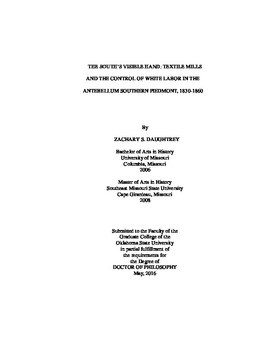| dc.contributor.advisor | Huston, James L. | |
| dc.contributor.author | Daughtrey, Zachary S. | |
| dc.date.accessioned | 2017-02-22T22:11:52Z | |
| dc.date.available | 2017-02-22T22:11:52Z | |
| dc.date.issued | 2016-05 | |
| dc.identifier.uri | https://hdl.handle.net/11244/48935 | |
| dc.description.abstract | Throughout the antebellum period, the concept of control was a fundamental cornerstone of white southern society. Plantations exhibited the most lucid example of this control where the master dominated not only slaves but the physical environment as well. Yet elite white southerners felt poor whites also needed controlling. Poor whites, a landless, migratory group, roamed the southern countryside in search of employment and steady wages. If poor whites found employment, it was often tenant farming and, at times, as day-laborers on southern plantations. Although allowed to work on plantations, planter elites held varying degrees of ambivalence towards poor whites as well as a disdain for whites working in the fields doing what they deemed work unbecoming a member of the white race. | |
| dc.description.abstract | This study centers upon the relationship between textile mill management and the poor white labor forces within the southern Piedmont between 1830 and 1860. Focusing on poor white textile laborers, it concludes that elite southerners viewed poor whites as fundamentally different from the rest of white southern society, basing these views on contemporary scientific, religious, and historical thought. Furthermore, plantations and textile mills, as well as mill villages, operated in strikingly similar ways. Poor whites, limited in their ability to purchase land already held by plantation masters, entered into industrial labor within textile mills and experienced numerous control measures within factories and mill villages. Ultimately, having experienced generations of harsh treatment by elites, poor whites entered into mill employment and did not take part in organized labor resistance or activism, unlike industrial employees in the Upper South and North. This deference can be attributed to a lack of rival foreign-born labor as well as psychosocial behaviors caused by the experience of poor whites in the antebellum Piedmont. | |
| dc.format | application/pdf | |
| dc.language | en_US | |
| dc.rights | Copyright is held by the author who has granted the Oklahoma State University Library the non-exclusive right to share this material in its institutional repository. Contact Digital Library Services at lib-dls@okstate.edu or 405-744-9161 for the permission policy on the use, reproduction or distribution of this material. | |
| dc.title | South's visible hand: Textile mills and the control of white labor in the antebellum southern Piedmont, 1830-1860 | |
| dc.contributor.committeeMember | Logan, Michael | |
| dc.contributor.committeeMember | Sharlach, Tonia | |
| dc.contributor.committeeMember | Perkins, Stephen | |
| osu.filename | Daughtrey_okstate_0664D_14534.pdf | |
| osu.accesstype | Open Access | |
| dc.type.genre | Dissertation | |
| dc.type.material | Text | |
| thesis.degree.discipline | History | |
| thesis.degree.grantor | Oklahoma State University | |
